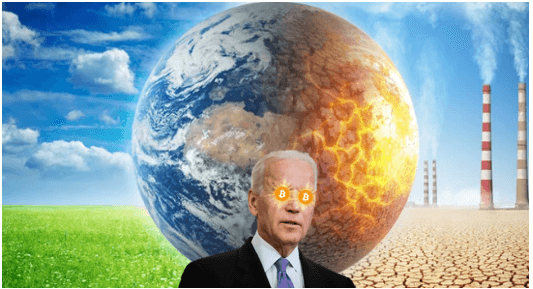On Wednesday September 8th, the White House Office of Science and Technology Policy (OSTP) released a report on crypto-assets and their impact on the climate and energy use. The report concluded that crypto makes a large contribution to greenhouse gas emissions due to high energy needs. The report recommends a large increase in governmental oversight and regulation in the crypto industry.
This report comes on the heels of a Bank of International Settlement Report that also explored crypto and climate change earlier this year.
Below we summarize what the key arguments were and the resulting recommendations.
White House’s OSTP Report on Climate Impact of Crypto
The OSTP report stemmed from the March Executive Order (EO) on the development of digital assets. Executive Order 14067 on “Ensuring the Responsible Development of Digital Assets” directed OSTP and other federal agencies to produce a report on climate and energy implications of crypto in the US.
In the press release accompanying the report, the White House calls climate change “one of the most pressing problems confronting our nation and our world”. The release also reiterates the goal of “net-zero greenhouse gas emissions by 2050” for the entirety of the US.
What Did the OSTP Report Find?
Crypto assets use energy and the US government’s report takes an anti-crypto stance, shocking no one.
From 2018 to 2022, crypto electricity usage is estimated to have 2x to 4x and currently consumes between 120 to 240 billion kilowatt-hours a year. They note this is more than entire countries like Argentina & Australia.
Currently crypto is using 0.4% to 0.9% of total annual global electricity, which is comparable to all conventional data centers in the world. Most of the electricity usage is driven by the Proof-of-Work (PoW) consensus mechanism underlying Bitcoin and Ethereum .(Though with the merge imminent, ETH PoW is for a limited time). The report attributes 60 to 77% of total electricity usage to Bitcoin and 20 to 39% to Ethereum.
The report also indicates that if all crypto moved to Proof-of-Stake (PoS) the overall power usage would drop to less than 1% of todays level.
US Specific Findings of Crypto Report
The United States is estimated to host ~1/3 of the total crypto-asset operations and nearly 40% of the global Bitcoin activity. This is up 3.5% from 2020. (Editor’s guess this is partially due to more adaption and partially due to the China crackdown on mining.

Additionally, with European energy costs currently soaring, mining in the Eurozone will be less profitable and cause a higher shift to US & abroad).
The report goes on to mention various measures and ‘climate’ costs of crypto assets in the US. The report compares these to other industries and the press release makes sure to use ‘scare bolding’:
- US crypto operations consume between 0.9% to 1.7% of the total US electricity usage. The report highlights this is similar to the electricity used by all US home computers or residential lighting.
- Additionally the greenhouse gas emissions of crypto make up 0.4% to 0.8% of all US emissions. The report compares this to the emissions from all diesel fuel used by railroads.
- Local noise and water are impacted from crypto and can “exacerbate environmental justice issues for communities”
- The growth of “energy-intensive” crypto technology can “hinder the ability of the US to achieve the National Determined Contributions from the Paris Agreement.
The conclusion is that crypto requires “action by the federal government to encourage and ensure responsible development”. We will repeat that here as it is the antithesis of one of the main benefits seen of crypto (decentralization and not under government control).
“Crypto requires action by the federal government to encourage and ensure responsible development”
-White House Crypto & Climate Change Impact Report
Recommendations of the OSTP Crypto Climate Change Report
The press release ends with the following key recommendations to “ensure the responsible development of digital assets”:
- Minimize greenhouse gas emissions, environmental justice impacts, and other local impacts from crypto-assets
- Use the Environmental Protection Agency (EPA), Department of Energy (DOE), and other federal agencies to oversee crypto development. The agencies should enact standards for 1) very low energy usage. 2) low water usage. 3) low noise generation. 4) Use of clean energy. 5) Carbon-free generation.
- If the agencies’ recommendations don’t reach a net-neutral result, the WH or Congress should legislate to eliminate ‘high-energy consensus mechanisms’
- Ensure energy reliability
- The DOE, Federal Energy Regulatory Commission (FERC), North American Electric Reliability Corporation, and regional entities should conduct reliability assessments.
- If reliability assessments find risks, the entities should develop and enforce standards to limit those risks
- Obtain data to understand, monitor, and mitigate impacts
- The Energy Information Administration and other federal agencies should collect and analyze information on crypto operation energy usage.
- OSTP could establish a ‘National Science and Technology Council’ subcommittee to coordinate with other agencies on energy usage
- Advance energy efficiency standards
- WH & Congress should enable DOE to update regulations on crypto mining equipment and operations
- Encourage transparency and improvements in environmental performance
- Crypto industry should publicly disclose crypto-asset mining locations, electricity usage, greenhouse gas emissions and electronic waste recycling performance
- Further research to improve understanding and innovation
- The National Science Foundation (NSF), DOE, EPA, and other federal agencies should support research and development to improve environmental sustainability of crypto.
As can be expected, the results of the report is to recommend more government intervention and oversight.
Conclusion – White Houses Crypto & Climate Change Report
There is nothing shocking in the White House’s crypto energy use & climate impact report. The US government appears determined to continue to discourage crypto and the report uses the ‘climate crises’ as another avenue to target the technology. The OSTP report is 1 of five expected from the Biden Admin EO. The Justice Department released a report on strengthening international law enforcement of crypto. Additionally, the Treasury Department issued a report on a potential framework for international engagement.
Anyone who is a believer in the decentralization and anonymous nature of crypto should be concerned by the laundry list of federal agencies named in the report as potential regulators of the industry.
Lastly, there is a comparison of Visa, Mastercard, and American Express versus the crypto industry. The conclusion is that the 3 major corporations combined consumed 1% of the electricity that Bitcoin and Ethereum used. This is a common stat thrown out by those against crypto, but an independent research report came to the conclusion that Bitcoin uses 56 times less energy than the current banking system. (The Valuechain study chose to not cherry pick a single debit transaction, but instead look at the entirety of the banking system.)
There has been a decentralized effort to address climate change in the crypto industry, with KlimaDao being one of the most visible (and so far unprofitable) examples.
Expect more environmental ‘FUD’ against crypto as the industry continues to grow and gain adoption.










